Abstract
BACKGROUND: There is a need for a new respiratory symptoms questionnaire for use in epidemiological research in asthma. METHOD: A questionnaire was designed following a pilot study in 78 subjects. It contains nine questions on symptoms such as wheeze and difficulty with breathing in defined circumstances such as exercise and sleep. It was completed by 211 adults and validated by comparison with a self reported history of asthma and with bronchial hyperresponsiveness to histamine. Its short term reproducibility was measured by three repeat administrations over two weeks. RESULTS: Subjects with asthma (n = 33), particularly those having had an asthma attack in the last year (n = 23), were more likely to report any symptom and to report a greater number of symptoms than those without asthma. The same relationship was found for bronchial hyperresponsiveness and symptoms. Either two or more, or three or more, symptoms appeared to be good indices of self reported asthma and bronchial hyperresponsiveness, or both, with a high sensitivity (65-91%) and specificity (85-96%). Reproducibility was good, with few subjects changing the number of symptoms reported by more than one symptom and none by more than four symptoms. The results compared favourably with those from questions on phlegm production from the MRC questionnaire and were better than those reported for the MRC wheeze questions. CONCLUSIONS: The questionnaire will be useful for epidemiological research on asthma and could form part of a new standardised questionnaire with wide applications.
Full text
PDF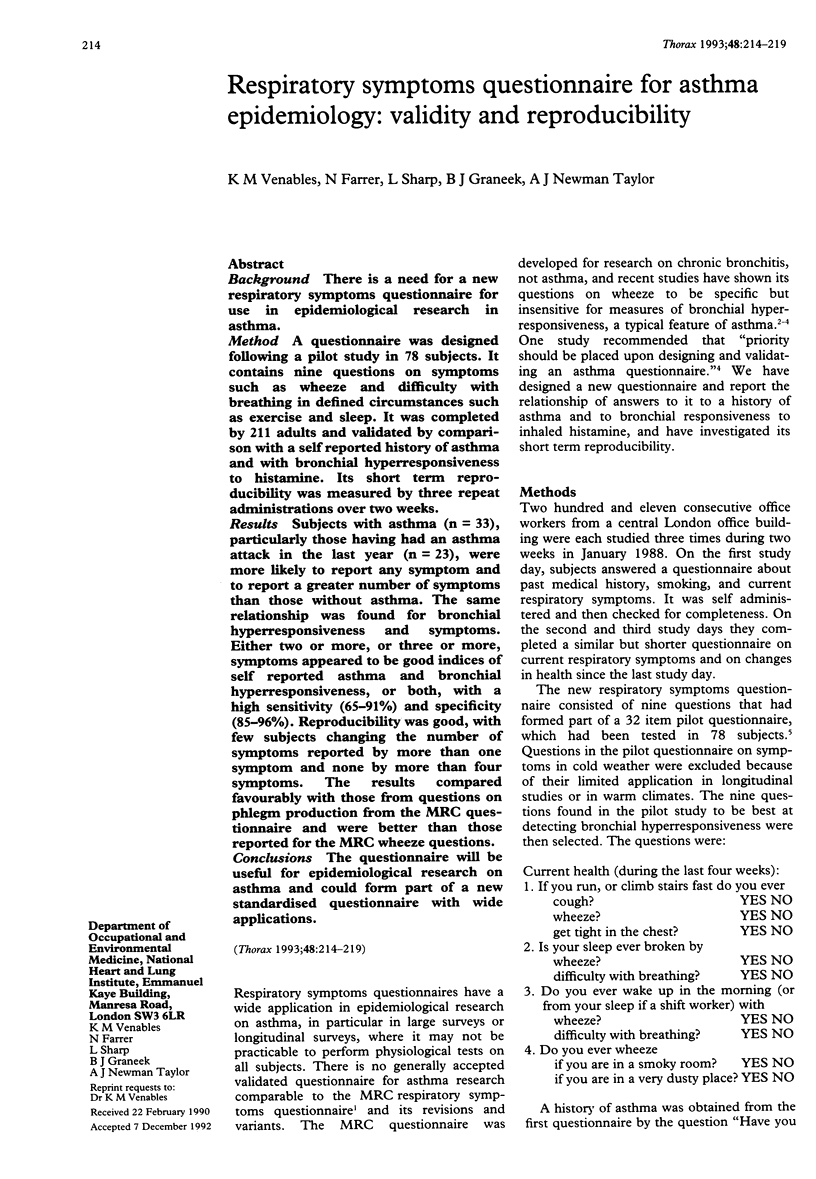
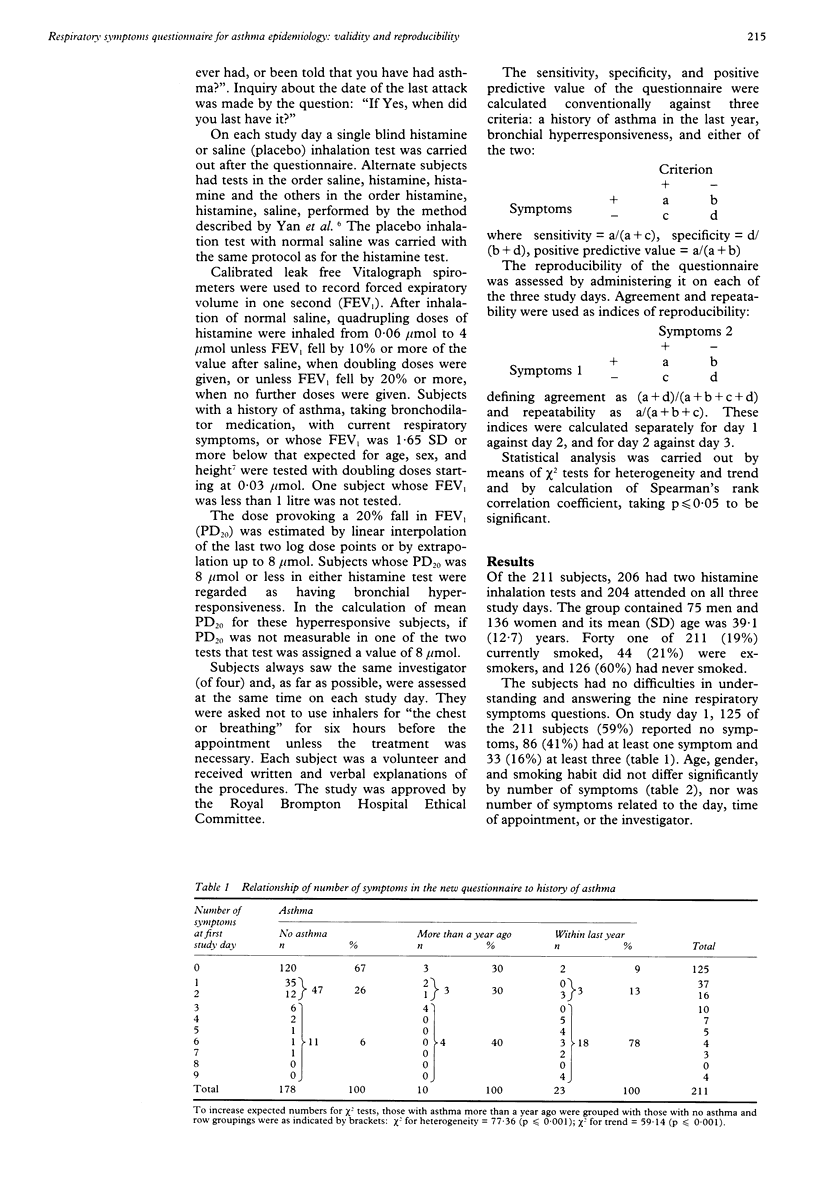
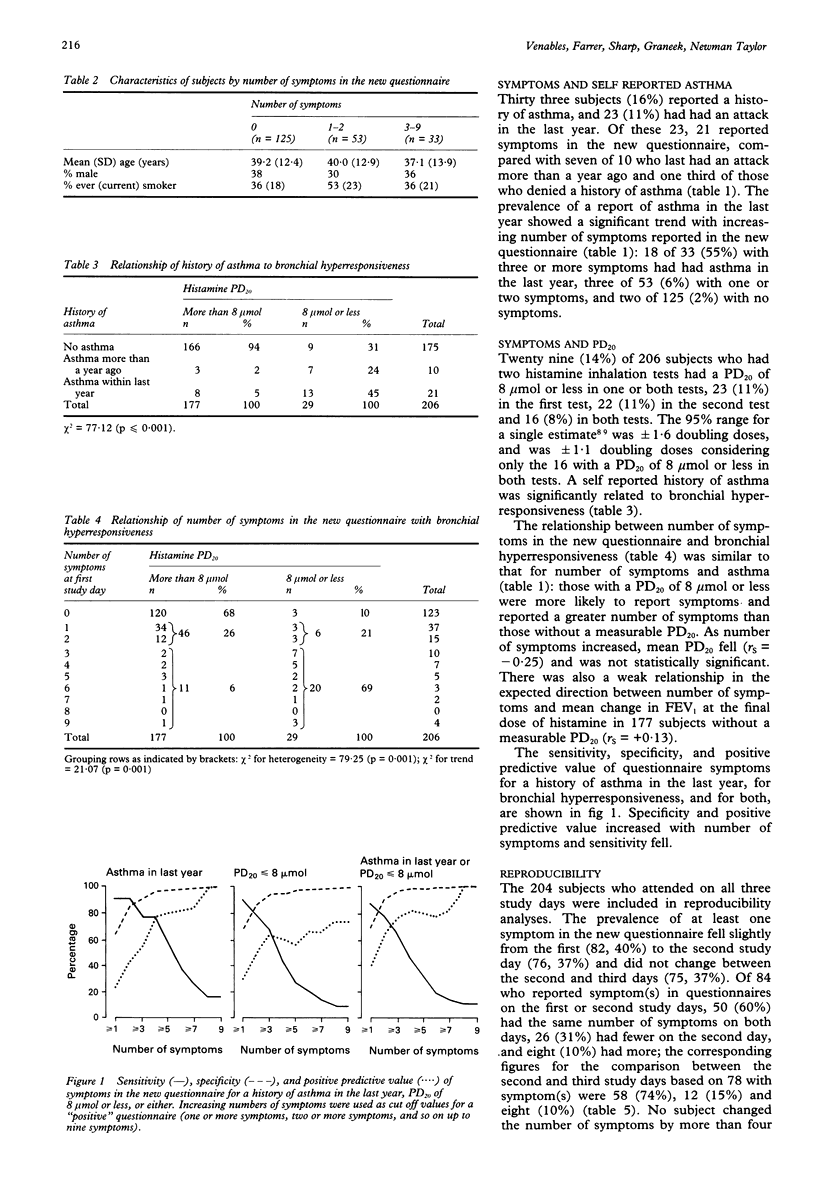
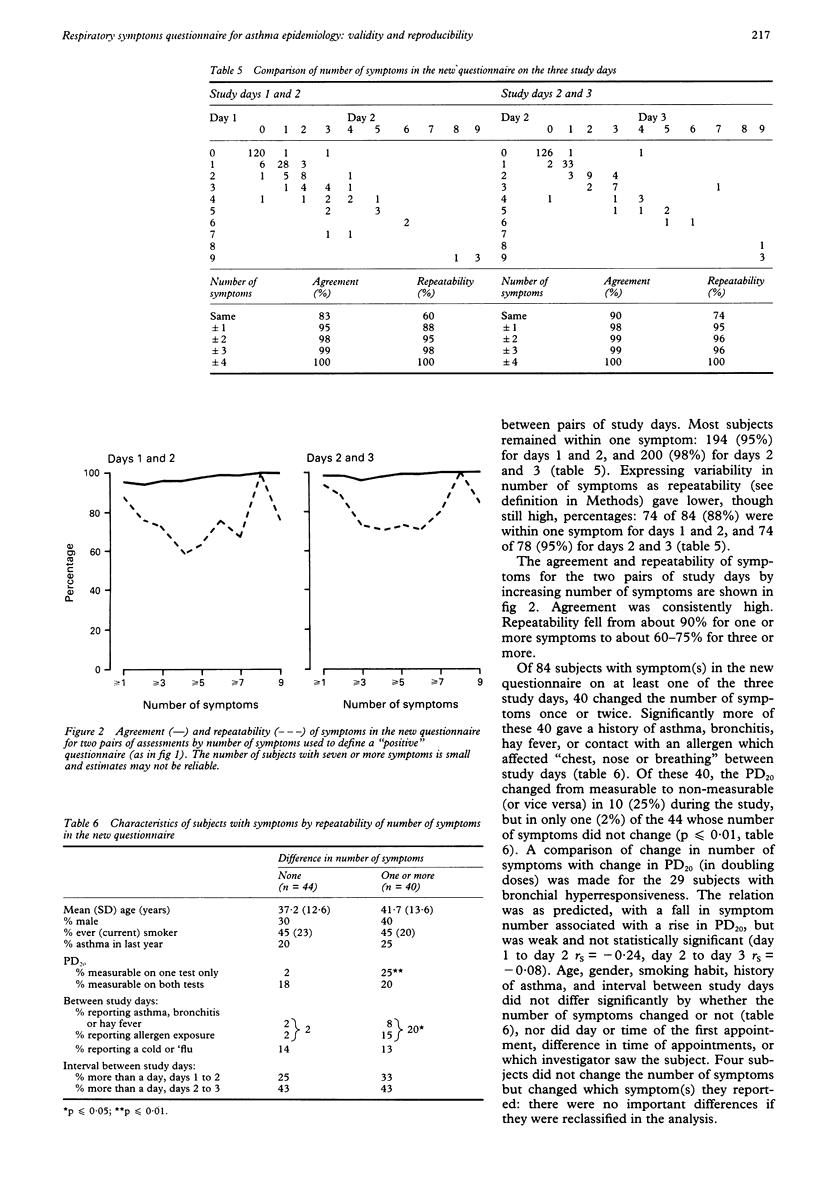
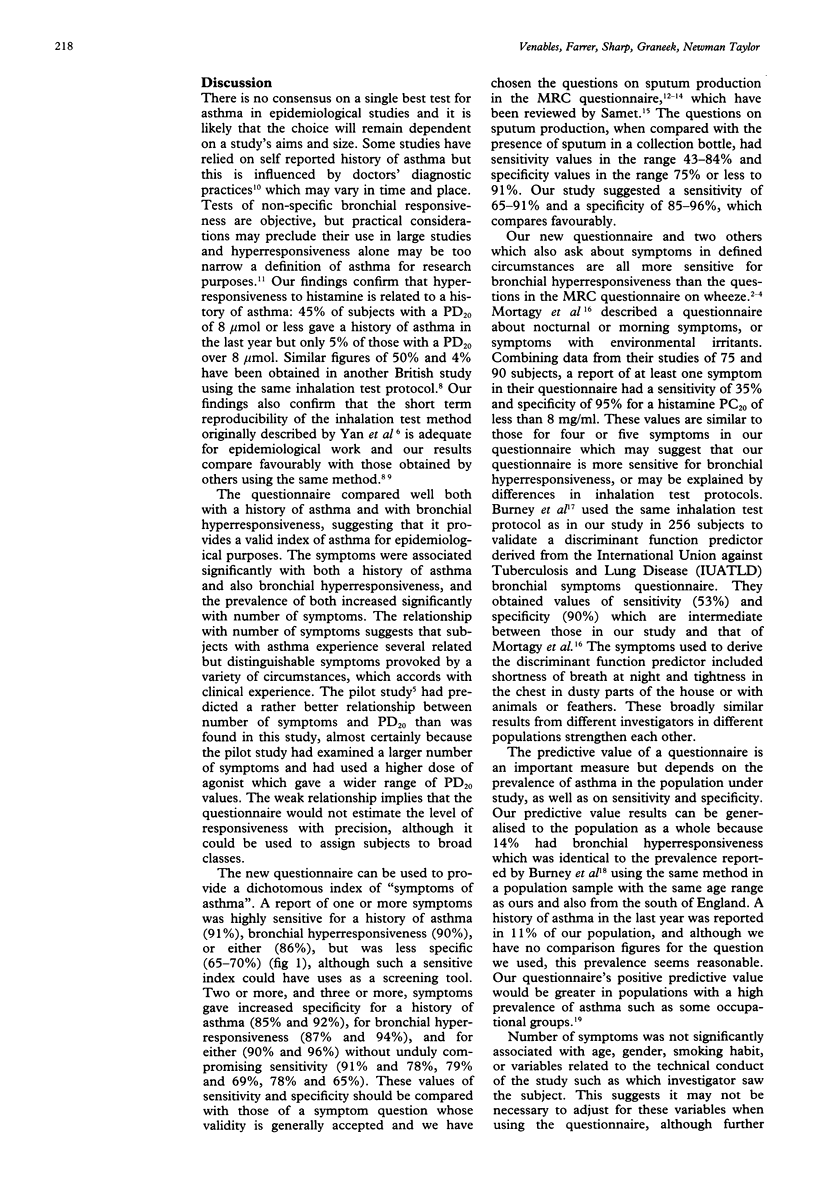

Selected References
These references are in PubMed. This may not be the complete list of references from this article.
- Burney P. G., Britton J. R., Chinn S., Tattersfield A. E., Papacosta A. O., Kelson M. C., Anderson F., Corfield D. R. Descriptive epidemiology of bronchial reactivity in an adult population: results from a community study. Thorax. 1987 Jan;42(1):38–44. doi: 10.1136/thx.42.1.38. [DOI] [PMC free article] [PubMed] [Google Scholar]
- Burney P. G., Chinn S., Britton J. R., Tattersfield A. E., Papacosta A. O. What symptoms predict the bronchial response to histamine? Evaluation in a community survey of the bronchial symptoms questionnaire (1984) of the International Union Against Tuberculosis and Lung Disease. Int J Epidemiol. 1989 Mar;18(1):165–173. doi: 10.1093/ije/18.1.165. [DOI] [PubMed] [Google Scholar]
- Burrows B. The natural history of asthma. J Allergy Clin Immunol. 1987 Sep;80(3 Pt 2):373–377. doi: 10.1016/0091-6749(87)90052-2. [DOI] [PubMed] [Google Scholar]
- Chinn S., Britton J. R., Burney P. G., Tattersfield A. E., Papacosta A. O. Estimation and repeatability of the response to inhaled histamine in a community survey. Thorax. 1987 Jan;42(1):45–52. doi: 10.1136/thx.42.1.45. [DOI] [PMC free article] [PubMed] [Google Scholar]
- Dales R. E., Ernst P., Hanley J. A., Battista R. N., Becklake M. R. Prediction of airway reactivity from responses to a standardized respiratory symptom questionnaire. Am Rev Respir Dis. 1987 Apr;135(4):817–821. doi: 10.1164/arrd.1987.135.4.817. [DOI] [PubMed] [Google Scholar]
- Enarson D. A., Vedal S., Schulzer M., Dybuncio A., Chan-Yeung M. Asthma, asthmalike symptoms, chronic bronchitis, and the degree of bronchial hyperresponsiveness in epidemiologic surveys. Am Rev Respir Dis. 1987 Sep;136(3):613–617. doi: 10.1164/ajrccm/136.3.613. [DOI] [PubMed] [Google Scholar]
- FLETCHER C. M., ELMES P. C., FAIRBAIRN A. S., WOOD C. H. The significance of respiratory symptoms and the diagnosis of chronic bronchitis in a working population. Br Med J. 1959 Aug 29;2(5147):257–266. doi: 10.1136/bmj.2.5147.257. [DOI] [PMC free article] [PubMed] [Google Scholar]
- FLETCHER C. M., TINKER C. M. Chronic bronchitis. A further study of simple diagnostic methods in a working population. Br Med J. 1961 May 27;1(5238):1491–1498. doi: 10.1136/bmj.1.5238.1491. [DOI] [PMC free article] [PubMed] [Google Scholar]
- Fletcher C. M., Peto R., Tinker C. M. A comparison of the assessment of simple bronchitis (chronic mucus hypersecretion) by measurements of sputum volume and by standardized questions on phlegm production. Int J Epidemiol. 1974 Dec;3(4):315–319. doi: 10.1093/ije/3.4.315. [DOI] [PubMed] [Google Scholar]
- Higgins B. G., Britton J. R., Chinn S., Jones T. D., Vathenen A. S., Burney P. G., Tattersfield A. E. Comparison of histamine and methacholine for use in bronchial challenge tests in community studies. Thorax. 1988 Aug;43(8):605–610. doi: 10.1136/thx.43.8.605. [DOI] [PMC free article] [PubMed] [Google Scholar]
- Holland W. W., Ashford J. R., Colley J. R., Morgan D. C., Pearson N. J. A comparison of two respiratory symptoms questionnaires. Br J Prev Soc Med. 1966 Apr;20(2):76–96. doi: 10.1136/jech.20.2.76. [DOI] [PMC free article] [PubMed] [Google Scholar]
- Lebowitz M. D., Burrows B. Comparison of questionnaires: the BMRC and NHLI respiratory questionnaires and a new self-completion questionnaire. Am Rev Respir Dis. 1976 May;113(5):627–635. doi: 10.1164/arrd.1976.113.5.627. [DOI] [PubMed] [Google Scholar]
- MORGAN D. C., PASQUAL R. S., ASHFORD J. R. SEASONAL VARIATIONS IN THE MEASUREMENT OF VENTILATORY CAPACITY AND IN THE ANSWERS OF WORKING COAL MINERS TO A RESPIRATORY SYMPTOMS QUESTIONARY. Br J Prev Soc Med. 1964 Apr;18:88–97. doi: 10.1136/jech.18.2.88. [DOI] [PMC free article] [PubMed] [Google Scholar]
- McNab G. R., Slator E. J., Stewart C. J. Response to a questionnaire on chronic bronchitic symptoms in East Anglia. Br J Prev Soc Med. 1966 Oct;20(4):181–188. doi: 10.1136/jech.20.4.181. [DOI] [PMC free article] [PubMed] [Google Scholar]
- Mortagy A. K., Howell J. B., Waters W. E. Respiratory symptoms and bronchial reactivity: identification of a syndrome and its relation to asthma. Br Med J (Clin Res Ed) 1986 Aug 30;293(6546):525–529. doi: 10.1136/bmj.293.6546.525. [DOI] [PMC free article] [PubMed] [Google Scholar]
- Rijcken B., Schouten J. P., Weiss S. T., Speizer F. E., van der Lende R. The relationship of nonspecific bronchial responsiveness to respiratory symptoms in a random population sample. Am Rev Respir Dis. 1987 Jul;136(1):62–68. doi: 10.1164/ajrccm/136.1.62. [DOI] [PubMed] [Google Scholar]
- Samet J. M. A historical and epidemiologic perspective on respiratory symptoms questionnaires. Am J Epidemiol. 1978 Dec;108(6):435–446. doi: 10.1093/oxfordjournals.aje.a112642. [DOI] [PubMed] [Google Scholar]
- Scadding J. G. Asthma and bronchial reactivity. Br Med J (Clin Res Ed) 1987 May 2;294(6580):1115–1116. doi: 10.1136/bmj.294.6580.1115-a. [DOI] [PMC free article] [PubMed] [Google Scholar]
- Venables K. M. Epidemiology and the prevention of occupational asthma. Br J Ind Med. 1987 Feb;44(2):73–75. doi: 10.1136/oem.44.2.73. [DOI] [PMC free article] [PubMed] [Google Scholar]
- Yan K., Salome C., Woolcock A. J. Rapid method for measurement of bronchial responsiveness. Thorax. 1983 Oct;38(10):760–765. doi: 10.1136/thx.38.10.760. [DOI] [PMC free article] [PubMed] [Google Scholar]
- van der Lende R., Orie N. G. The MRC-ECCS questionnaire on respiratory symptoms (use in epidemiology). Scand J Respir Dis. 1972;53(4):218–226. [PubMed] [Google Scholar]


